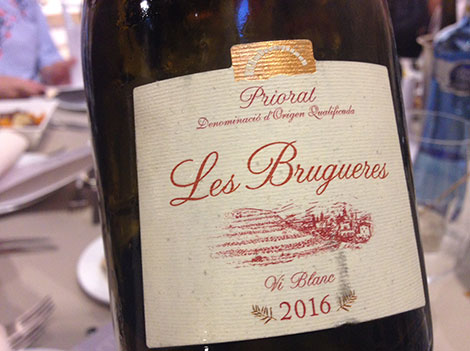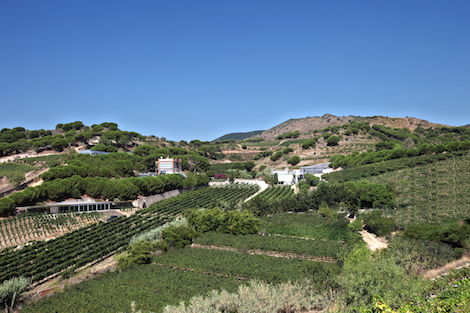
When La Conreria de Scala Dei was established in Priorat in the late 1990s, 70% of its vineyards were planted with white grapes. Such an unusual circumstance in a predominantly red wine area led them to think white for their flagship wine. Les Brugueres (€16.30, 2016 vintage, Vinissimus) is a single-varietal Garnacha Blanca. The style is far more consistent than most young whites with zesty acidity and a pleasant finish.
Winemaker and co-owner Jordi Vidal sources grapes from 21 different plots which are fermented separately in up to 28 batches. Up to 43,000 bottles are made, which account for 40% of the winery’s total production. In terms of their vineyards, the 19 hectares owned by La Conreria represent 18% of the 108 hectares under white vines registered by the Regulatory Board as of 1 January 2017. An original, off-the-beaten-track project.
The diversity of white varieties in Priorat
With 60 hectares under vine, Garnacha Blanca is Priorat’s leading white grape followed by Macabeo (21Ha.) and Pedro Ximénez (10Ha.) I tasted the single-varietal Roureda Llicorella PX 2015 (1,800 bottles) made by Cellers Unió at Poboleda’s cooperative in the Vi de Vila (village wine) category. With no oak at all, there was some complexity from the lees and an interesting briny character.
Locally called Pansal, Xarel.lo is relatively rare, yet those producers who work with it say that the quality is outstanding and that it has adapted well to the area. The rarest grape in Priorat may be Escanya-Vella (literally “old women throttler”). Albert Costa from Vall Llach says it was very common to see some of these plants in the vineyards so that old women pickers could eat them as they worked. The only 100% Escanya-Vella wine found in the area is Celler Ripoll Sans’ Gratallops Vi de Vila.
Other white grapes allowed in the appellation include Muscat of Alexandria, Muscat à Petit Grains, Blanquilla, Picapoll Blanc and international varieties Chenin Blanc and Viognier. Compared to the 1,850 hectares of red vines in the area, white vine surface is rather anecdotal. But the trend is changing, with an increasing number of producers including white wines in their range.
It is the case of Mas d’en Gil, a producer who planted white vines in its Bellmunt estate in 2000. These grapes now go to the Bellmunt Vi de Vila, a blend of Garnacha Blanca and Viognier, and to Coma Alta Garnacha Blanca with one third of the wine aged in barrels. The estate’s oldest vines, planted on schist, river pebbles and clay soils in 1941 and 1945, are reserved for its premium wine Coma Blanca (€41.90, 2013 vintage at Decántalo or via Wine Searcher). The 2014 vintage I tasted at Espai Priorat was sapid and elegant with oak less noticeable than in previous vintages. It will be released with a new packaging –they have shifted from Bordeaux to Burgundy-shaped bottles with labels inspired in the fonts of old estate-bottlings when the business was owned by the Barril family.
Terroir al Limit’s white adventure
More significantly, some producers who started making reds are now trying to equate their white and red wine productions. A notable example is Terroir al Limit, whose white range is as varied as it is distinctive. Driven by his love for food –he finds that whites are the perfect match for good meal— owner Dominik A. Huber brought all his whites to the tasting held at Scala Dei’s monastery including some limited releases. It is an original range, with an interesting choice of grape varieties, soils and fermentation and aging vessels and the use of skin contact techniques.
It starts with Terra de Cuques 2015 (around 16,000 bottles, €29.95 at Decántalo). The wine is fermented with stems and skins for ten days and is later aged for 16 months in concrete tanks. The blend of Pedro Ximénez from clay soils in El Lloar and 10% Muscat form schist soils in Porrera makes it a serious, mineral white with a refined skin contact expression. The 2015 Muscat (1,198 bottles, €35.90 at Vinissimus) is fine and displays floral and Mediterranean herb aromas whereas Cartoixà Xarel.lo 2016 (668 botlles, €38.90, 2014 vintage at Ideavinos) is more structured and briny. These three whites are ideal with food. The top-of-the-range Pedra de Guix 2014 (€51.90 at Vinissimus or via Wine Searcher) is the only one that avoids skin contact. A blend of Garnacha Blanca grown on schist, Macabeo from alluvial soils and Pedro Ximénez grown on clay, this is a richer, more complex wine a slightly oxidative character.
Huber is trying to increase his white production with the launch of an affordable range of regional wines (there’s also a red wine) called Terroir Historic made in the old Torroja cooperative. Terroir Historic white (€16.40, 2015 vintage at Alforins; from €20.69, 2016 vintage via Wine Searcher) blends 75% Garnacha Blanca and 25% Macabeo and is fermented with skins and aged in concrete tanks for 6 months. Despite some reductive notes on the nose, the palate is fresh and mouth-watering with generous fruit. Around 15,000 bottles are made but this figure is expected to grow in the future. Terroir al Limit owns five hectares of white grapes; 40,000 bottles out of the 100,000 it produces are white.
The evolution of Nelín
Another producer betting on white wines is Clos Mogador. According to René Barbier Jr, their white Nelín —which was first released in the 2000 vintage (it was called Clos Nelín at the time)— is set to become a village wine (vi de vila) from Gratallops. His idea is to increase production to the levels of Clos Mogador, their top red wine.
Nelín has experimented quite a few changes over time. Initially a barrel-fermented Garnacha Blanca, it was later blended with Marsanne, Roussanne and Viognier; even some directly pressed Pinot Noir made its way into it. But it soon became clear that these grapes were not adapted to Priorat’s warm climate. Our of the local varieties, says René, Macabeo lowers acidity and it is slightly reductive, while Pedro Ximénez and Escanya-Vella don’t help much in terms of acidity. From his point of view, Xarel.lo is the best choice and they’re planting it on high northern-exposed areas with the aim of bringing down alcohol levels and increase freshness.
Since the 2011 vintage, steps have been taken in this direction following the success of Partida Bellvisos, a white made by René Jr and his wife Sara Pérez (Mas Martinet). Spontaneous fermentation and 20% of skins were introduced in Nelín, aging times in foudre increased and the wine spends some time in stainless steel tanks before bottling. The 2014 vintage (€34.25 at Decántalo or via Wine Searcher) displays lively dry and fresh herb notes with a distinctively mineral palate with dry stones and some salinity. It is not the style you’d expect to find in Priorat.
The obscure, exotic Carinyena Blanca
In terms of breaking new ground, the new Planetes de Nin 2015 white (2,000 bottles, €28.50 at Vila Viniteca) stands out. This 100% Carinyena Blanca comes from the recovery and reproduction of a couple of plants found in the area by Ester Nin and husband Carles Ortiz. This variety, which is grown in Empordà (northern Catalonia), is not authorized in Priorat but it could had been grown in the area during pre-phylloxera times. The label states “Vi blanc de varietats antigues” (white wine made from ancient grape varieties) but the name of the grape appears only on the cork.
Mediterranean herbs are present on the nose, but I could also find floral notes (jasmine), raw almonds and a strong citrus character adding tension to the palate. This a vibrant, almost crystalline wine with a notable long finish. One of Carinyena Blanca’s main features is its low alcohol, which may prove a blessing in the area. Given that a minimum 13% vol. is required in the appellation, Ester and Carles pick up grapes at different times to ensure they get the maximum ripeness the variety is capable of.
Viognier: going international
Perhaps the most surprising thing about Priorat whites is that, with some exceptions, the overall profile is fresher than the reds. It even happens with Viognier, one of the handful of international varieties that reached the area at the end of the 20th century.
Vall Llach’s single varietal Aigua de Llum 2016 (around 800 bottles, €48.45, 2015 vintage at Vinissumus) avoids the hot profile expected in this area; instead, I found a balanced, persistent wine. It comes from 25-year-old vines planted at 540m of altitude; fermentation takes place in stainless steel tanks and then the wine is aged for 3-4 months in French oak barrels with moderate toast levels.
Font de la Figuera 2016 from Clos Figueras (€21.60 at Decántalo or via Wine Searcher) is a more affordable option. A brand which has been around since the 1990s, it blends Viognier with Garnacha Blanca and 5% Chenin Blanc resulting in a fruity style (preserved lemons) but always with a distinctive herbal character.

Amaya Cervera
A wine journalist with almost 30 years' experience, she is the founder of the award-winning Spanish Wine Lover website. In 2023, she won the National Gastronomy Award for Gastronomic Communication
NEWSLETTER
Join our community of Spanish wine lovers






